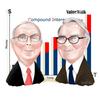July Market Review And Thoughts Going Forward

“We don’t have to be fast; we simply have to be steady and move in the right direction.” – Toni Sorenson
Q2 2021 hedge fund letters, conferences and more
When my great-grandfather came to this country in 1900 at 4-years-old, his family had nothing. Later, he dropped out of elementary school to help support them. Despite lacking formal education, he managed to accumulate a modest-sized fortune through a lifetime of 80-hour workweeks running his own businesses, being extremely cheap, and buying properties.
He left much of this fortune to his daughter, my grandmother. Although she was a smart woman, as she got older, she developed dementia. Through a variety of scams and speculations, a good portion of that fortune was lost. Real life doesn’t always have a happy ending like it does in popular movies, but this one was bittersweet: by spending hundreds of thousands of dollars in legal fees, we were able to prevent the total loss of my great-grandfather's legacy.
When we spend our days crunching numbers and picking apart companies to invest in, it’s easy to forget why we do this. But I believe that my grandmother’s life could have been improved through better planning, investing, and legal protection. And so could the lives of many others.
Last Month’s Winners & Losers
| Winners | Losers |
| Larger companies | Chinese Internet companies |
| Profitable companies | Riskier companies |
| Long-term momentum stocks | Oil & gas companies |
Large stocks continued to perform well last month, outperforming smaller stocks-as evidenced by the S&P 500 returning 2.3% vs. -3.7% for the Russell 2000, a 6% spread in one month. Despite that, small stocks still have stronger returns over the last year.
Profitable companies and long-term momentum stocks-those with strong 3-5 year returns-performed well last month. Riskier companies-as measured by price volatility and debt load-performed poorly. Other factor groups, such as value, growth, and near-term momentum, showed mixed performance.
Of particular note was the bloodbath in Chinese Internet stocks, following the Chinese government’s crackdown on Didi and other Chinese companies operating abroad. This seems to be an issue of data security and the control of data, which is important to governments on either side of the Pacific.
Oil and gas stocks were off by around 8% for the month, even though the underlying price of oil did not move much over the month. This was led by an 8.7% decline in Exxon Mobil (XOM), despite posting second quarter earnings stronger than consensus and analysts raising consensus estimates (per FactSet). This seems to be related to OPEC increasing production targets, slowing Chinese factory growth, and fears of the Covid Delta-variant causing another disruption in demand for oil.
Equity Review
| S&P 500 | Russell 2000 | MSCI EAFE | |
| (large stocks) | (small stocks) | (international stocks) | |
| Last Month Return | 2.30% | -3.70% | 1.70% |
| Last 12mos Return | 36.50% | 52.00% | 30.50% |
| Dividend Yield | 1.30% | 1.00% | 1.70% |
| Earnings Yield | 4.30% | 5.60% | 4.90% |
| Earnings Growth | 10.10% | 12.60% | 11.10% |
| Return on Equity | 17.80% | 11.60% | 14.10% |
| % Losing Money | 11.10% | 36.70% | 10.50% |
Source: FactSet as of 7/31/2021. Dividend Yield is an estimate based on the weighted average of all companies in the index (by market cap). Earnings Yield is an estimate based on the weighted average of all profitable companies in the index. Earnings Growth, and Return on Equity are estimates based on the median profitable company. The % Losing Money statistic represents the percent of stocks with negative earnings in the preceding 12-month period. The characteristics below the Russell 2000 are based on 2,000 small cap stocks meant to act as a proxy to the stocks in the Russell 2000 but are not necessarily in the Russell 2000 index. The characteristics below the MSCI EAFE are based on the 1,000 largest companies in the developed countries outside of North America, as defined by the MSCI EAFE, but are not necessarily in the MSCI EAFE index.
Despite the strong performance of small cap stocks over the last year, they still lag over the last 10 years. The market leaders have been the largest handful of companies-in fact, the largest five companies now make up nearly a quarter of the S&P 500’s total market value.
While the leading companies are very strong in terms of market position, profitability, and growth, such concentration is at a level not seen in decades. Concentration of wealth and power has historically invited blowback in a variety of realms-political, legal, and economic. So, whether this is sustainable is an open question.
Related to the strong performance of the largest companies is the valuation level of large companies. A 4.3% earnings yield is slim by historical standards-but then again, interest rates are historically low too, so it’s not like large investors have great alternatives to put a lot of capital to work.
Where there is some more attractive valuation available is in the less “sexy” stocks that are perhaps not as well-known and not as dominant, but still posting solid profitability and growth. Companies like these are available both in large cap stocks outside of the big tech companies and in smaller stocks.
Some of the smaller stocks’ higher earnings yield is justified as compensation because smaller stocks tend to be riskier. In fact, around 37% of them lost money over the last year vs. just 11% of large companies (source: FactSet). But if you can separate the money-losing ones from the profitable ones, there are some good quality companies available at attractive valuations. Being small, they also often have higher growth potential than companies that are already large.
Income Review
| Interest Rates | Dividend Yields | ||
| 1yr Treasuries | 0.1% | Common Stocks | 1.3% |
| 10yr Treasuries | 1.3% | Preferred Stocks | 5.0% |
| Muni Bonds (5yr AAA) | 0.4% | Real Estate (REITs) | 2.8% |
| Brokered CDs (5yr) | 1.0% | Financials | 2.2% |
| Corporate Bonds (5yr A) | 1.1% | Utilities | 3.2% |
| Annuities (5yr A) | 2.2% | Energy | 3.0% |
Source: Interest rates from Raymond James' Weekly Interest Rate Monitor as of 7/26/2021. Annuity rates from Raymond James' Annuity Rate Watch as of 7/31/2021. Source for the Dividend Yields is from FactSet. Common Stocks uses the estimated dividend yield for the S&P 500. Preferred Stocks is the average dividend yield of the 100 largest traded preferred stocks (by dollar volume, per FactSet). REIT, Financials, Utilities, and Energy dividend yields are the average of those sector stocks included in the 1,000 largest common stocks.
Investors who want safe, conservative income continue to be in a bind. If you expect inflation to be 2-3% or higher, as I do, then the current yields of around 1% for quality securities suggest a negative real return. You may get your principal back, but that principal will be worth less as inflation depreciates the value of the dollar. What to do about this depends on your personal goals, time horizon, risk tolerance, and more.
For investors with the means and ability to take more risk, there are other options, such as dividend-paying stocks, real estate, and even limited partnerships (in certain circumstances). While these suffer the risk of principal loss, they could potentially provide income that might increase with profitability and could potentially outpace inflation.
Proprietary Strategies
Last month I finished setting up my three proprietary strategies:
- Blue Chip Focus - a strategy of around 20 large cap stocks, focused on the ones I believe have the best risk-return trade-off.
- Small Cap Focus - a strategy of around 20-30 small cap stocks, focused on the ones I believe have the best risk-return trade-off.
- Equity Income - a strategy of around 20-30 stocks with above-average dividend yields, focused on the ones I believe have the best risk-return trade-off and prospects for dividend growth over time.
While the universe for each of these strategies differs (large stocks, small stocks, dividend-paying stocks), the philosophy and investment process is the same: a focus on the stocks I believe are the best for that universe of stocks.
INVESTMENT UNIVERSE
▼
MODEL RANK
▼
BUYS
In other words, I start with the investment universe. For large cap stocks, that would be around 1,000 companies. Then I apply the quantitative models I’ve developed based on over 20 years of research experience to look at those ranked in the top 20%. For large cap stocks, that’s around 200 companies. Finally, I engage in fundamental research to select the ones I believe are the best for the strategy, diversified by sector and industry, and risk characteristics.
The most important characteristics I seek in the companies I select for my strategies are: a strong market position, substantial growth potential over the next 5-10 years, potential to benefit from technological and other change, substantial profitability and cash flow potential, capital efficiency, little or no debt, and attractive value.
Nostradamus Hat
In this section I put on my “Nostradamus Hat” and make some predictions, for whatever they’re worth (which isn’t much). No one’s predictions are reliable, least of all mine, so this is just for fun and should not be considered relevant to any investment strategy. With all that said, here are a few of my “gut” predictions:
- Inflation will pick up over the next year and more.
- The economy will continue recovering.
- The Delta variant is serious from a health perspective and will cause disruption but I believe it will not be material to the financial markets overall.
- OPEC will do as OPEC does.
- China will continue to assert disputed territory claims but will not start a war over them.
- China will become somewhat more “walled off” in data, investment opportunities, and more-slightly moderating the trend toward openness seen in the last few decades.
- Although there’s always something to worry about, we’re in a bull market and I believe stocks will go higher.
While everyone has “gut” predictions, I do not base investment strategy on such things. I look for quality companies that could potentially do well in a variety of economic environments. A good investment strategy is balanced, suited to individual needs, adaptable to changing circumstances, and resilient to different environments. Including situations we can’t predict.
RANDALL WATSEK, CFA®, CFP®
Financial Advisor, Raymond James Branch 3GO, T 914.689.3615 // F 844.275.4520 // raymondjames.com, 41 South Moger Avenue, Mount Kisco, NY 10549, Raymond James & Associates, Inc. member NYSE/SIPC.
Please visit http://raymondjames.com/smrja.htm for Additional Risk and Disclosure Information. Raymond James does not accept private client orders or account instructions by email. This email: (a) is not an official transaction confirmation or account statement; (b) is not an offer, solicitation, or recommendation to transact in any security; (c) is intended only for the addressee; and (d) may not be retransmitted to, or used by, any other party. This email may contain confidential or privileged information; please delete immediately if you are not the intended recipient. Raymond James monitors emails and may be required by law or regulation to disclose emails to third parties.
Investment products are: Not deposits. Not FDIC Insured. Not guaranteed by the financial institution. Subject to risk. May Lose Value.
This may constitute a commercial email message under the CAN-SPAM Act of 2003. If you do not wish to receive marketing or advertising related email messages from us, please reply to this message with “unsubscribe” in your response. You will continue to receive emails from us related to servicing your account(s).
Updated on
Source valuewalk






